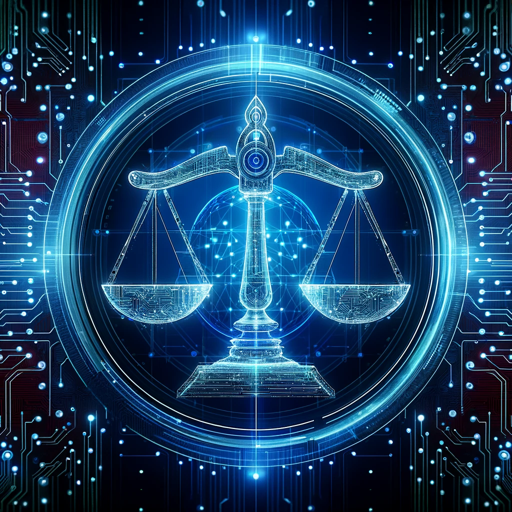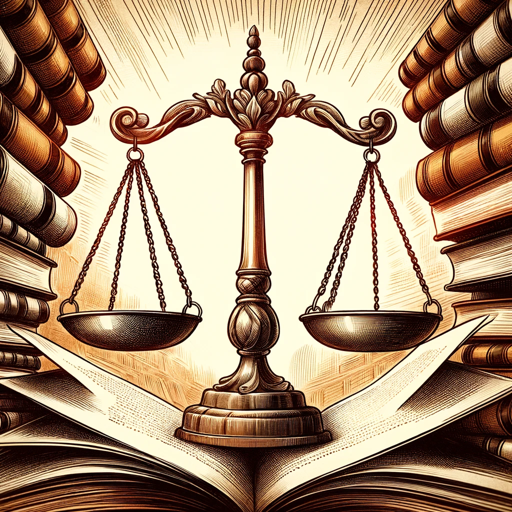Criminal Justice-criminal justice information resource.
AI-powered tool for criminal justice insights.
Want to learn about Criminal Justice?!
Related Tools
Load More
Oráculo Jurídico Criminalista (Direito Penal)
Assistente especializado em Direito Penal Brasileiro, oferecendo auxílio em defesa criminal, consultoria em improbidade administrativa, suporte em investigações, elaboração de petições etc. Possuo acesso a legislações e jurisprudências atualizadas. Fins E

Jura & Recht - Mentor
Der Assistent für das Jurastudium
JusValdo
Assistente de busca jurisprudencial para Advogados

True Crime
Dives into true crime stories with detailed analysis

Law & Order
Your AI legal assistant
DOUTOR CRIMINAL
Direito Penal e Processual Penal
20.0 / 5 (200 votes)
Introduction to Criminal Justice
Criminal justice refers to the system of practices and institutions that governments use to maintain social control, deter and mitigate crime, and sanction those who violate laws. The primary components of the criminal justice system include law enforcement, courts, and corrections. Each plays a critical role in ensuring that justice is served, while also upholding the legal rights of individuals. For example, law enforcement agencies investigate crimes and arrest suspects, while courts are responsible for adjudicating those suspects to determine guilt or innocence. Finally, corrections handle the rehabilitation or punishment of convicted offenders. A scenario illustrating this would be a theft case: the police would investigate the crime and apprehend a suspect, the courts would determine the suspect’s guilt, and the correctional system would impose a suitable punishment.

Main Functions of the Criminal Justice System
Law Enforcement
Example
Police officers investigate crimes, gather evidence, and make arrests.
Scenario
In a case of burglary, law enforcement officers gather fingerprints, interview witnesses, and apprehend the suspect.
Adjudication (Courts)
Example
Courts ensure a fair trial where the defendant’s guilt or innocence is determined.
Scenario
In a robbery trial, the court assesses evidence from both the prosecution and defense to decide the outcome.
Corrections
Example
Corrections manage sentencing, including incarceration, probation, or parole.
Scenario
A convicted offender is sentenced to two years in prison, followed by supervised parole to reintegrate into society.
Ideal Users of Criminal Justice Services
Law Enforcement Agencies
Police departments and investigative bodies benefit from the criminal justice system to support their role in crime prevention, investigation, and arrests. They require the legal framework and judicial cooperation provided by the criminal justice system to ensure proper evidence collection, enforcement of laws, and due process.
Legal Professionals and Courts
Judges, prosecutors, and defense attorneys rely on the criminal justice system to adjudicate criminal cases. They use the system to interpret and apply laws, protect defendants' rights, and ensure justice is delivered in a fair and timely manner. The structured court process is essential for balancing the interests of the state and individual freedoms.

How to Use Criminal Justice
Visit aichatonline.org for a free trial without login, no need for ChatGPT Plus.
Begin by visiting the official website where you can access Criminal Justice features without requiring a subscription or a ChatGPT Plus account.
Explore the available knowledge base.
Once inside, navigate through the categories to find relevant criminal justice topics, such as laws, case precedents, and criminal theories.
Input your specific query or topic.
Use the search function to input precise legal questions, such as ‘mala in se vs mala prohibita,’ or ask about specific cases.
Review detailed responses.
The system will generate a detailed response, often incorporating examples from historical cases, laws, or criminal justice principles.
Use additional features for in-depth analysis.
You can explore related case law, legal definitions, or advanced studies in criminal behavior, policies, and justice reform.
Try other advanced and practical GPTs
Thinkscript Trader
AI-powered Thinkscript coding for traders.

Check Grammar Only
AI-powered grammar correction, simplified.

Answer Only; No Explanation
AI-Powered Direct Answer Tool

Label Safety Checker
AI-powered label safety analysis

CharmChat | Tinder, Bumble, Hinge Ice Breakers
AI-powered ice breakers for dating

Export/Import Opportunity Identifier
AI-powered tool for export/import opportunities

Offer Craftsman Pro
Craft AI-powered sales offers easily

Catholic Brother
AI-powered Catholic knowledge and support.

최저가 쇼핑 - 가격 비교 (쿠팡, 네이버, G마켓, 신세계, 현대, 다나와) 🛒
AI-powered price comparison across top shopping sites.

Da Vinci brother
AI-powered tool for realistic, historical images.

Ecommerce Category Or Collection SEO GPT Generator
AI-Driven Product Categorization for SEO Success

Pass Any Test
Ace any test with AI-powered precision.

- Legal Research
- Policy Analysis
- Case Law
- Crime Trends
- Restorative Justice
Criminal Justice Q&A
What is the difference between mala in se and mala prohibita crimes?
Mala in se crimes are inherently evil, such as murder and rape, while mala prohibita crimes are actions deemed illegal by societal standards, like loitering or speeding.
How is discretion used in the criminal justice system?
Discretion is exercised by actors such as law enforcement, judges, and prosecutors at various points in the process, influencing decisions about arrests, charges, and sentencing.
What are some contemporary trends in criminal justice reform?
Recent trends include bail reform, changes to sentencing practices, increased victim involvement through restorative justice, and efforts to reduce racial disparities in the system.
How has technology impacted criminal justice?
Technology has introduced challenges like cybercrime and data privacy concerns, while also aiding in surveillance, evidence collection, and case management through digital tools.
What are some philosophies of punishment?
The four main philosophies of punishment include retribution, deterrence, rehabilitation, and incapacitation, each with different aims such as reducing recidivism or protecting society.